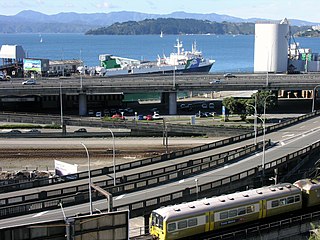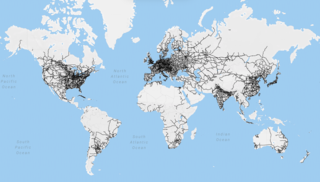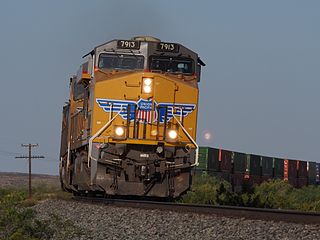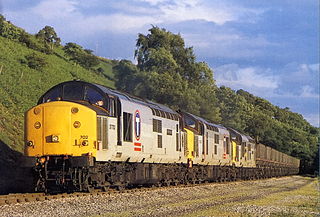Related Research Articles

Transport in New Zealand, with its mountainous topography and a relatively small population mostly located near its long coastline, has always faced many challenges. Before Europeans arrived, Māori either walked or used watercraft on rivers or along the coasts. Later on, European shipping and railways revolutionised the way of transporting goods and people, before being themselves overtaken by road and air, which are nowadays the dominant forms of transport. However, bulk freight still continues to be transported by coastal shipping and by rail transport, and there are attempts to (re)introduce public transport as a major transport mode in the larger population centres.

Rail transport is a means of transferring passengers and goods on wheeled vehicles running on rails, which are located on tracks. In contrast to road transport, where the vehicles run on a prepared flat surface, rail vehicles are directionally guided by the tracks on which they run. Tracks usually consist of steel rails, installed on ties (sleepers) set in ballast, on which the rolling stock, usually fitted with metal wheels, moves. Other variations are also possible, such as "slab track", in which the rails are fastened to a concrete foundation resting on a prepared subsurface.

A train is a form of rail transport consisting of a series of connected vehicles that generally run along a railroad track to transport passengers or cargo. The word "train" comes from the Old French trahiner, derived from the Latin trahere meaning "to pull" or "to draw".

A truck or lorry is a motor vehicle designed to transport cargo. Trucks vary greatly in size, power, and configuration. Smaller varieties may be mechanically similar to some automobiles. Commercial trucks can be very large and powerful and may be configured to be mounted with specialized equipment, such as in the case of refuse trucks, fire trucks, concrete mixers, and suction excavators. In American English, a commercial vehicle without a trailer or other articulation is formally a "straight truck" while one designed specifically to pull a trailer is not a truck but a "tractor".

The railway system of Great Britain started with the building of local isolated wooden wagonways starting in the 1560s. A patchwork of local rail links operated by small private railway companies developed in the late 18th century. These isolated links expanded during the railway boom of the 1840s into a national network, although still run by dozens of competing companies. Over the course of the 19th and early 20th centuries, these amalgamated or were bought by competitors until only a handful of larger companies remained. The entire network was brought under government control during the First World War and a number of advantages of amalgamation and planning were demonstrated. However, the government resisted calls for the nationalisation of the network. In 1923, almost all the remaining companies were grouped into the "Big Four": the Great Western Railway, the London and North Eastern Railway, the London, Midland and Scottish Railway and the Southern Railway. The "Big Four" were joint-stock public companies and they continued to run the railway system until 31 December 1947.

A traction engine is a steam-powered tractor used to move heavy loads on roads, plough ground or to provide power at a chosen location. The name derives from the Latin tractus, meaning 'drawn', since the prime function of any traction engine is to draw a load behind it. They are sometimes called road locomotives to distinguish them from railway locomotives – that is, steam engines that run on rails.
Seddon Atkinson Vehicles Limited, a manufacturer of large goods vehicles based in Oldham, Greater Manchester, England, was formed after the acquisition in 1970 of Atkinson Vehicles Limited of Preston by Seddon Diesel Vehicles Limited of Oldham. In 1974, the firm was acquired by International Harvester, which sold it in March 1984 to the Spanish group Enasa which made it a subsidiary of Pegaso. In 1990, it became part of Iveco which used the brand for various types of specialised vehicles in the United Kingdom. The range of models produced included EuroMover, Pacer and Strato, which are aimed at refuse collection, recycling and construction operators.

Rail freight transport is the use of railroads and trains to transport cargo as opposed to human passengers.

Vehicle and Operator Services Agency (VOSA) was an executive agency granted trading fund status in the United Kingdom sponsored by the Department for Transport of the United Kingdom Government.

Motoring taxation in the United Kingdom consists primarily of vehicle excise duty, which is levied on vehicles registered in the UK and hydrocarbon oil duty which is levied on the fuel used by motor vehicles. VED and fuel tax raised approximately GB£32 billion in 2009, a further £4 billion was raised from the value added tax on fuel purchases. Motoring-related taxes for fiscal year 2011/12, including fuel duties and VED, are estimated that will amount to more than GB£38 billion, representing almost 7% of total UK taxation.
This article is part of a series on the History of rail transport in Great Britain
The Road Haulage Association Ltd (RHA) is a private company limited by guarantee dedicated to the interests of the road haulage industry. It is the only trade association in the United Kingdom dedicated solely to road haulage. As a trade association, the RHA is responsible for campaigning, advice, training, information and business services for its members within the UK haulage industry, including audits, risk assessments and contracts of employment.

The 47 class are a class of diesel-electric locomotives built by A Goninan & Co for the Public Transport Commission in 1972-1973.

A steam wagon is a steam-powered road vehicle for carrying freight. It is the earliest form of lorry (truck) and came in two basic forms: overtype and undertype, the distinction being the position of the engine relative to the boiler. Manufacturers tended to concentrate on one form or the other.
The Road Fund was a British Government fund designated to pay for the building and maintenance of the United Kingdom road network. Its income came originally from Vehicle Excise Duty, until that ceased to be hypothecated for roads use in 1936, and then from government grants. It was created by the Roads Act 1920 and Finance Act 1920, and was wound up in the Miscellaneous Financial Provisions Act 1955.
Longer Heavier Vehicles (LHVs), also called super lorries, is a classification of large goods vehicle (LGV) in the United Kingdom. LHVs are not presently allowed to operate on UK roads, being longer and/or heavier than the legal limits, which as of 2009 allowed LGVs up to a maximum of 6 axles and 44 tonnes of fully laden vehicle weight, and a maximum overall length of 16.5 m for articulated lorries, or 18.75 m for drawbar lorries.
The Denby Eco-Link, dubbed the super lorry by the mainstream media, is a commercial vehicle designed and built by Denby Transport of the United Kingdom. The Eco-Link is a 60 tonne fully laden, 25.25m long, 8 axle B-Train type of semi-trailer truck, in which a tractor unit pulls two semi-trailers, using fifth wheel couplings on both trailers. As one prototype of the UK Longer Heavier Vehicle (LHV) vehicle definition, which are longer and heavier than normal Large Goods Vehicles, it is not currently permitted to be used in the UK. As of 2009, the largest ordinary lorries in the UK have 6 axles and a maximum laden weight of 44 tonnes, and can be 16.5m long as single trailer semi-trailer trucks, or 18.75m as drawbar lorries.
The Road Traffic Act 1934 was an Act of the Parliament of the United Kingdom introduced by the Minister of Transport, Leslie Hore-Belisha. The Act was made in a year in which there had been a record numbers of road casualties.

Road pricing in the United Kingdom used to be limited to conventional tolls in some bridges, tunnels and also for some major roads during the period of the Turnpike trusts. The term road pricing itself only came into common use however with publication of the Smeed Report in 1964 which considered how to implement congestion charging in urban areas as a transport demand management method to reduce traffic congestion.

The railway network in Great Britain has been used to transport goods of various types and in varying volumes since the early 19th century. Network Rail, which owns and maintains the network, aims to increase the amount of goods carried by rail. In 2015-16 Britain's railways moved 17.8 billion net tonne kilometres, a 20% fall compared to 2014-15. Coal accounted for 13.1% of goods transport in Britain, down considerably from previous years. There are no goods transported by railway in Northern Ireland.
References
- ↑ "Motor Taxation. Vehicles Using Fuel Oil (Letters)". The Times. 24 March 1933.
- ↑ "London Midland & Scottish Railway". The Times. 25 February 1933.
- ↑ "Commercial Use Of Roads". The Times. 15 February 1933.
- ↑ "Tax On Heavy Oils". The Times. 9 March 1934.
- ↑ "Road And Rail". The Times. 17 April 1933.
- ↑ Sir J. Stamp (31 January 1933). "Road And Rail - A Defence Of The Salter Report". The Times.
- ↑ "Proposals for Motorway Networks". Motorway Archive. 18 November 2007.
- ↑ "Trunk Roads Homepage". Cheshire County Council. Archived from the original on 17 October 2007.